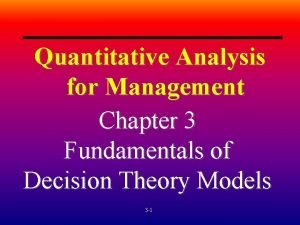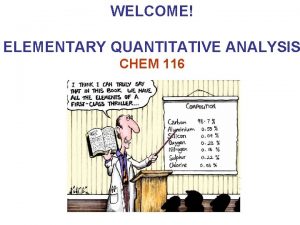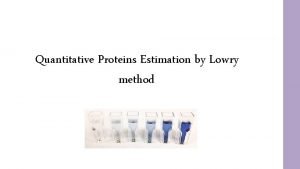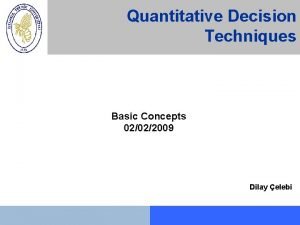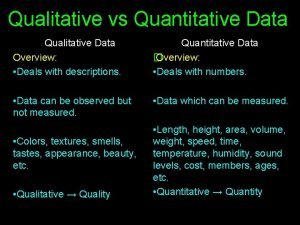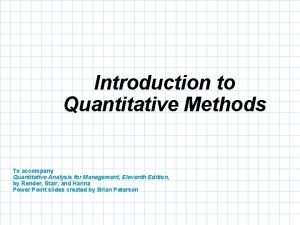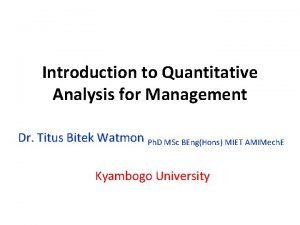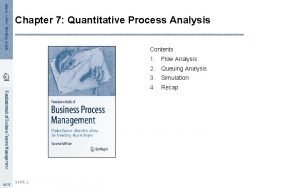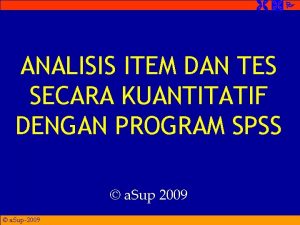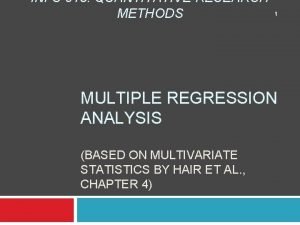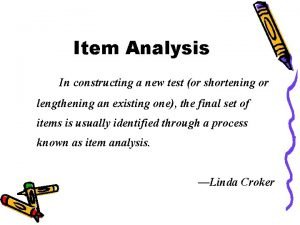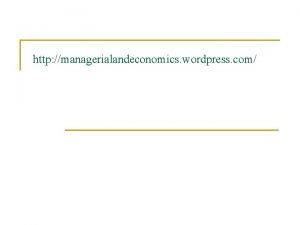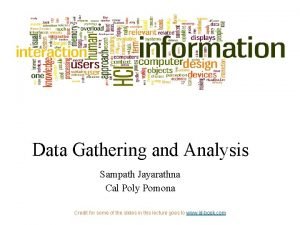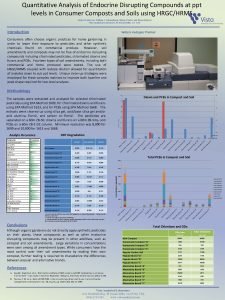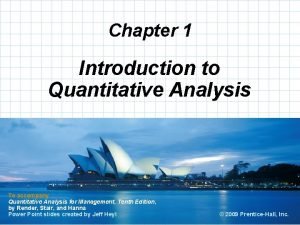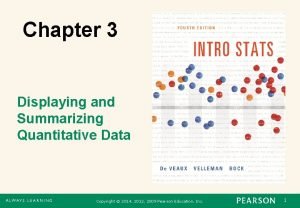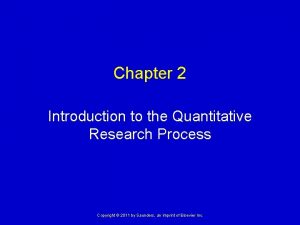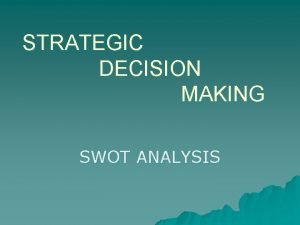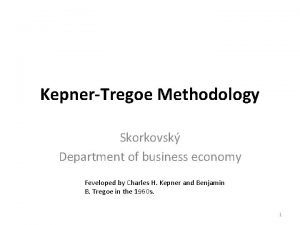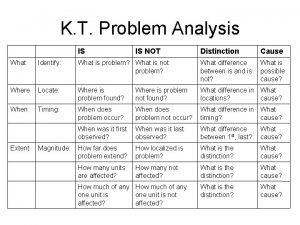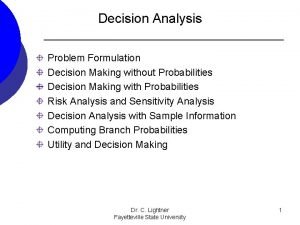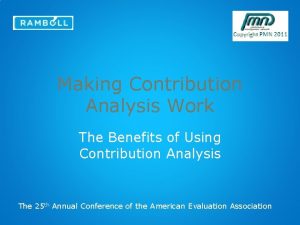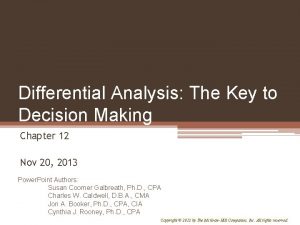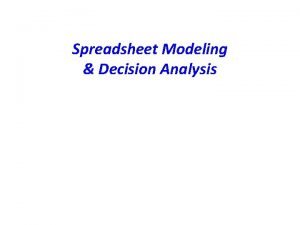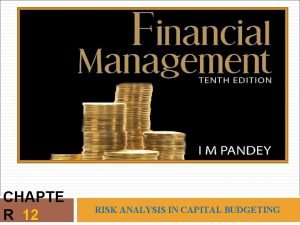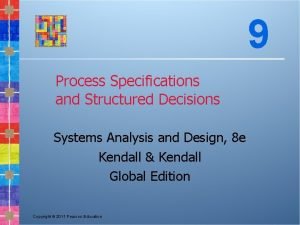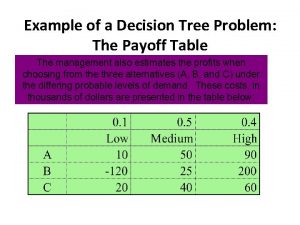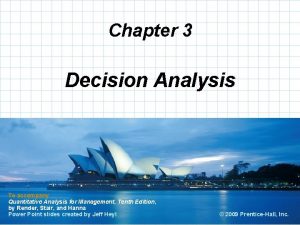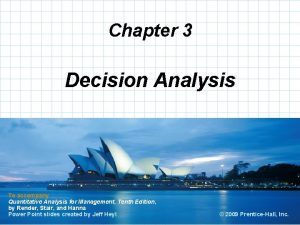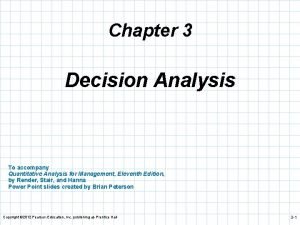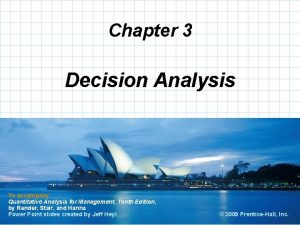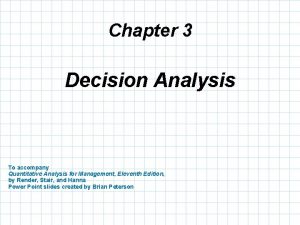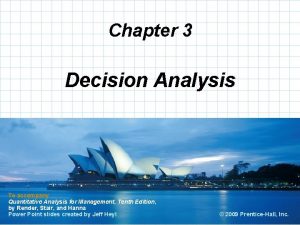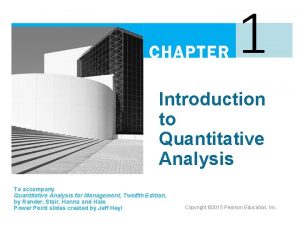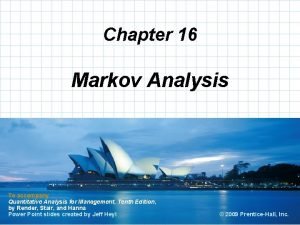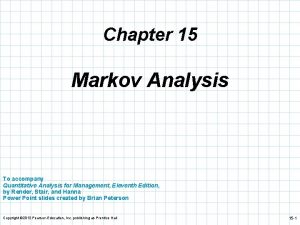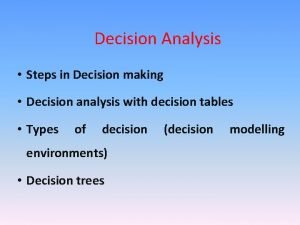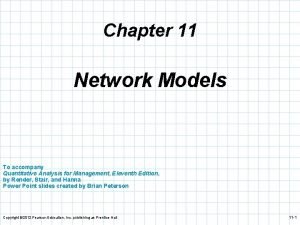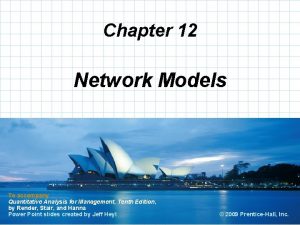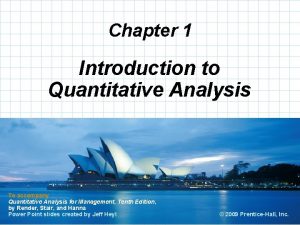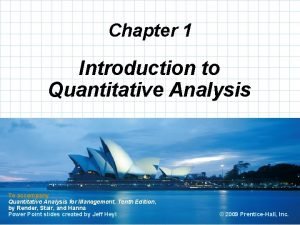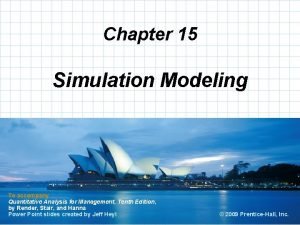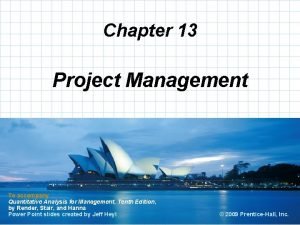Chapter 3 Decision Analysis To accompany Quantitative Analysis














































- Slides: 46

Chapter 3 Decision Analysis To accompany Quantitative Analysis for Management, Tenth Edition, by Render, Stair, and Hanna Power Point slides created by Jeff Heyl © 2008 Prentice-Hall, Inc. © 2009 Prentice-Hall, Inc.

Learning Objectives After completing this chapter, students will be able to: 1. List the steps of the decision-making process 2. Describe the types of decision-making environments 3. Make decisions under uncertainty 4. Use probability values to make decisions under risk © 2009 Prentice-Hall, Inc. 3– 2

Learning Objectives After completing this chapter, students will be able to: 5. Develop accurate and useful decision trees 6. Revise probabilities using Bayesian analysis 7. Use computers to solve basic decisionmaking problems 8. Understand the importance and use of utility theory in decision making © 2009 Prentice-Hall, Inc. 3– 3

Chapter Outline 3. 1 Introduction 3. 2 The Six Steps in Decision Making 3. 3 Types of Decision-Making Environments 3. 4 Decision Making under Uncertainty 3. 5 Decision Making under Risk 3. 6 Decision Trees 3. 7 How Probability Values Are Estimated by Bayesian Analysis © 2009 Prentice-Hall, Inc. 3– 4

Introduction n What is involved in making a good decision? n Decision theory is an analytic and systematic approach to the study of decision making n A good decision is one that is based on logic, considers all available data and possible alternatives, and the quantitative approach described here © 2009 Prentice-Hall, Inc. 3– 5

The Six Steps in Decision Making 1. 2. 3. 4. 5. 6. Clearly define the problem at hand List the possible alternatives Identify the possible outcomes or states of nature List the payoff or profit of each combination of alternatives and outcomes Select one of the mathematical decision theory models Apply the model and make your decision © 2009 Prentice-Hall, Inc. 3– 6

Thompson Lumber Company Step 1 – Define the problem n Expand by manufacturing and marketing a new product, backyard storage sheds Step 2 – List alternatives n Construct a large new plant n A small plant n No plant at all Step 3 – Identify possible outcomes n The market could be favorable or unfavorable © 2009 Prentice-Hall, Inc. 3– 7

Thompson Lumber Company Step 4 – List the payoffs n Identify conditional values for the profits for large, small, and no plants for the two possible market conditions Step 5 – Select the decision model n Depends on the environment and amount of risk and uncertainty Step 6 – Apply the model to the data n Solution and analysis used to help the decision making © 2009 Prentice-Hall, Inc. 3– 8

Thompson Lumber Company STATE OF NATURE ALTERNATIVE FAVORABLE MARKET ($) UNFAVORABLE MARKET ($) Construct a large plant 200, 000 – 180, 000 Construct a small plant 100, 000 – 20, 000 0 0 Do nothing Table 3. 1 © 2009 Prentice-Hall, Inc. 3– 9

Types of Decision-Making Environments Type 1: Decision making under certainty n Decision maker knows with certainty the consequences of every alternative or decision choice Type 2: Decision making under uncertainty n The decision maker does not know the probabilities of the various outcomes Type 3: Decision making under risk n The decision maker knows the probabilities of the various outcomes © 2009 Prentice-Hall, Inc. 3 – 10

Decision Making Under Uncertainty There are several criteria for making decisions under uncertainty 1. Maximax (optimistic) 2. Maximin (pessimistic) 3. Criterion of realism (Hurwicz) 4. Equally likely (Laplace) 5. Minimax regret © 2009 Prentice-Hall, Inc. 3 – 11

Maximax Used to find the alternative that maximizes the maximum payoff n Locate the maximum payoff for each alternative n Select the alternative with the maximum number STATE OF NATURE ALTERNATIVE FAVORABLE MARKET ($) UNFAVORABLE MARKET ($) MAXIMUM IN A ROW ($) Construct a large plant 200, 000 Construct a small plant 100, 000 – 20, 000 100, 000 0 Do nothing Table 3. 2 – 180, 000 200, 000 Maximax © 2009 Prentice-Hall, Inc. 3 – 12

Maximin Used to find the alternative that maximizes the minimum payoff n Locate the minimum payoff for each alternative n Select the alternative with the maximum number STATE OF NATURE ALTERNATIVE FAVORABLE MARKET ($) UNFAVORABLE MARKET ($) MINIMUM IN A ROW ($) Construct a large plant 200, 000 – 180, 000 Construct a small plant 100, 000 – 20, 000 0 Do nothing Table 3. 3 Maximin © 2009 Prentice-Hall, Inc. 3 – 13

Criterion of Realism (Hurwicz) A weighted average compromise between optimistic and pessimistic n Select a coefficient of realism n Coefficient is between 0 and 1 n A value of 1 is 100% optimistic n Compute the weighted averages for each alternative n Select the alternative with the highest value Weighted average = (maximum in row) + (1 – )(minimum in row) © 2009 Prentice-Hall, Inc. 3 – 14

Criterion of Realism (Hurwicz) n For the large plant alternative using = 0. 8 (0. 8)(200, 000) + (1 – 0. 8)(– 180, 000) = 124, 000 n For the small plant alternative using = 0. 8 (0. 8)(100, 000) + (1 – 0. 8)(– 20, 000) = 76, 000 STATE OF NATURE ALTERNATIVE FAVORABLE MARKET ($) UNFAVORABLE MARKET ($) CRITERION OF REALISM ( = 0. 8)$ Construct a large plant 200, 000 Construct a small plant 100, 000 – 20, 000 76, 000 0 Do nothing – 180, 000 124, 000 Realism Table 3. 4 © 2009 Prentice-Hall, Inc. 3 – 15

Equally Likely (Laplace) Considers all the payoffs for each alternative n Find the average payoff for each alternative n Select the alternative with the highest average STATE OF NATURE ALTERNATIVE FAVORABLE MARKET ($) UNFAVORABLE ROW MARKET ($) AVERAGE ($) Construct a large plant 200, 000 – 180, 000 10, 000 Construct a small plant 100, 000 – 20, 000 40, 000 0 0 Do nothing Equally likely 0 Table 3. 5 © 2009 Prentice-Hall, Inc. 3 – 16

Minimax Regret Based on opportunity loss or regret, regret the difference between the optimal profit and actual payoff for a decision n Create an opportunity loss table by determining the opportunity loss for not choosing the best alternative n Opportunity loss is calculated by subtracting each payoff in the column from the best payoff in the column n Find the maximum opportunity loss for each alternative and pick the alternative with the minimum number © 2009 Prentice-Hall, Inc. 3 – 17

Minimax Regret n Opportunity Loss Tables STATE OF NATURE FAVORABLE UNFAVORABLE MARKET ($) 200, 000 – 200, 000 0 – (– 180, 000) 200, 000 – 100, 000 0 – (– 20, 000) 200, 000 – 0 0– 0 Table 3. 6 ALTERNATIVE STATE OF NATURE FAVORABLE UNFAVORABLE MARKET ($) Construct a large plant 0 180, 000 Construct a small plant 100, 000 20, 000 Do nothing 200, 000 0 Table 3. 7 © 2009 Prentice-Hall, Inc. 3 – 18

Minimax Regret STATE OF NATURE ALTERNATIVE FAVORABLE MARKET ($) UNFAVORABLE MARKET ($) MAXIMUM IN A ROW ($) Construct a large plant 0 180, 000 Construct a small plant 100, 000 20, 000 100, 000 Do nothing 200, 000 0 Minimax 200, 000 Table 3. 8 © 2009 Prentice-Hall, Inc. 3 – 19

Decision Making Under Risk n Decision making when there are several possible states of nature and we know the probabilities associated with each possible state n Most popular method is to choose the alternative with the highest expected monetary value (EMV) EMV (alternative i) = (payoff of first state of nature) x (probability of first state of nature) + (payoff of second state of nature) x (probability of second state of nature) + … + (payoff of last state of nature) x (probability of last state of nature) © 2009 Prentice-Hall, Inc. 3 – 20

EMV for Thompson Lumber n Each market has a probability of 0. 50 n Which alternative would give the highest EMV? n The calculations are EMV (large plant) = (0. 50)($200, 000) + (0. 50)(–$180, 000) = $10, 000 EMV (small plant) = (0. 50)($100, 000) + (0. 50)(–$20, 000) = $40, 000 EMV (do nothing) = (0. 50)($0) + (0. 50)($0) = $0 © 2009 Prentice-Hall, Inc. 3 – 21

EMV for Thompson Lumber STATE OF NATURE ALTERNATIVE FAVORABLE MARKET ($) UNFAVORABLE MARKET ($) EMV ($) Construct a large plant 200, 000 – 180, 000 10, 000 Construct a small plant 100, 000 – 20, 000 40, 000 0 0. 50 Do nothing Probabilities Table 3. 9 Largest EMV © 2009 Prentice-Hall, Inc. 3 – 22

Expected Value of Perfect Information (EVPI) n EVPI places an upper bound on what you should pay for additional information EVPI = EVw. PI – Maximum EMV n EVw. PI is the long run average return if we have perfect information before a decision is made EVw. PI = (best payoff for first state of nature) x (probability of first state of nature) + (best payoff for second state of nature) x (probability of second state of nature) + … + (best payoff for last state of nature) x (probability of last state of nature) © 2009 Prentice-Hall, Inc. 3 – 23

Expected Value of Perfect Information (EVPI) n Scientific Marketing, Inc. offers analysis that will provide certainty about market conditions (favorable) n Additional information will cost $65, 000 n Is it worth purchasing the information? © 2009 Prentice-Hall, Inc. 3 – 24

Expected Value of Perfect Information (EVPI) 1. Best alternative for favorable state of nature is build a large plant with a payoff of $200, 000 Best alternative for unfavorable state of nature is to do nothing with a payoff of $0 EVw. PI = ($200, 000)(0. 50) + ($0)(0. 50) = $100, 000 2. The maximum EMV without additional information is $40, 000 EVPI = EVw. PI – Maximum EMV = $100, 000 - $40, 000 = $60, 000 © 2009 Prentice-Hall, Inc. 3 – 25

Expected Value of Perfect Information (EVPI) 1. Best alternative for favorable state of nature is build a large plant with a payoff of $200, 000 So the maximum Thompson Best alternative for unfavorable of nature is should pay for the state additional to do nothinginformation with a payoff $0 is of $60, 000 EVw. PI = ($200, 000)(0. 50) + ($0)(0. 50) = $100, 000 2. The maximum EMV without additional information is $40, 000 EVPI = EVw. PI – Maximum EMV = $100, 000 - $40, 000 = $60, 000 © 2009 Prentice-Hall, Inc. 3 – 26

Expected Opportunity Loss n Expected opportunity loss (EOL) is the n n cost of not picking the best solution First construct an opportunity loss table For each alternative, multiply the opportunity loss by the probability of that loss for each possible outcome and add these together Minimum EOL will always result in the same decision as maximum EMV Minimum EOL will always equal EVPI © 2009 Prentice-Hall, Inc. 3 – 27

Expected Opportunity Loss STATE OF NATURE ALTERNATIVE Construct a large plant Construct a small plant Do nothing Probabilities FAVORABLE MARKET ($) 0 UNFAVORABLE MARKET ($) 180, 000 EOL 90, 000 100, 000 20, 000 60, 000 200, 000 0. 50 100, 000 Table 3. 10 Minimum EOL (large plant) = (0. 50)($0) + (0. 50)($180, 000) = $90, 000 EOL (small plant) = (0. 50)($100, 000) + (0. 50)($20, 000) = $60, 000 EOL (do nothing) = (0. 50)($200, 000) + (0. 50)($0) = $100, 000 © 2009 Prentice-Hall, Inc. 3 – 28

Decision Trees n Any problem that can be presented in a decision table can also be graphically represented in a decision tree n Decision trees are most beneficial when a sequence of decisions must be made n All decision trees contain decision points or nodes and state-of-nature points or nodes n A decision node from which one of several alternatives may be chosen n A state-of-nature node out of which one state of nature will occur © 2009 Prentice-Hall, Inc. 3 – 29

Five Steps to Decision Tree Analysis 1. 2. 3. 4. 5. Define the problem Structure or draw the decision tree Assign probabilities to the states of nature Estimate payoffs for each possible combination of alternatives and states of nature Solve the problem by computing expected monetary values (EMVs) for each state of nature node © 2009 Prentice-Hall, Inc. 3 – 30

Structure of Decision Trees start from left to right n Represent decisions and outcomes in sequential order n Squares represent decision nodes n Circles represent states of nature nodes n Lines or branches connect the decisions nodes and the states of nature © 2009 Prentice-Hall, Inc. 3 – 31

Thompson’s Decision Tree A State-of-Nature Node Favorable Market A Decision Node 1 ct nt u r st Pla n e Co arg L Favorable Market Construct Small Plant Do Unfavorable Market No th 2 Unfavorable Market in g Figure 3. 2 © 2009 Prentice-Hall, Inc. 3 – 32

Thompson’s Decision Tree EMV for Node 1 = $10, 000 = (0. 5)($200, 000) + (0. 5)(–$180, 000) Favorable Market (0. 5) Alternative with best EMV is selected 1 ct nt u r st Pla n e Co arg L Favorable Market (0. 5) Construct Small Plant Do No 2 th Figure 3. 3 Unfavorable Market (0. 5) in g Unfavorable Market (0. 5) EMV for Node 2 = $40, 000 Payoffs $200, 000 –$180, 000 $100, 000 –$20, 000 = (0. 5)($100, 000) + (0. 5)(–$20, 000) $0 © 2009 Prentice-Hall, Inc. 3 – 33

Thompson’s Complex Decision Tree First Decision Point Second Decision Point Payoffs Favorable Market (0. 78) 5). 4 0 ( y ts e e rv sul abl u S Re or v 1 Sur Fa ve Re y ( Ne su 0. 5 5) ga lts tiv e ge Small Plant Lar 2 3 Do Favorable Market (0. 27) t g Lar n Pla e Small Plant 4 5 Not Unfavorable Market (0. 73) Favorable Market (0. 27) Unfavorable Market (0. 73) rve y nt Pla ge Small Plant Lar 6 7 Unfavorable Market (0. 50) Favorable Market (0. 50) Unfavorable Market (0. 50) No Plant –$190, 000 $90, 000 –$30, 000 $190, 000 –$190, 000 $90, 000 –$30, 000 –$10, 000 Favorable Market (0. 50) Con duc $190, 000 –$10, 000 No Plant t Su Figure 3. 4 Unfavorable Market (0. 22) Favorable Market (0. 78) Unfavorable Market (0. 22) No Plant Co nd uc t. M ar ke t. S ur ve y t n Pla $200, 000 –$180, 000 $100, 000 –$20, 000 $0 © 2009 Prentice-Hall, Inc. 3 – 34

Thompson’s Complex Decision Tree 1. Given favorable survey results, EMV(node 2) = EMV(large plant | positive survey) = (0. 78)($190, 000) + (0. 22)(–$190, 000) = $106, 400 EMV(node 3) = EMV(small plant | positive survey) = (0. 78)($90, 000) + (0. 22)(–$30, 000) = $63, 600 EMV for no plant = –$10, 000 2. Given negative survey results, EMV(node 4) = EMV(large plant | negative survey) = (0. 27)($190, 000) + (0. 73)(–$190, 000) = –$87, 400 EMV(node 5) = EMV(small plant | negative survey) = (0. 27)($90, 000) + (0. 73)(–$30, 000) = $2, 400 EMV for no plant = –$10, 000 © 2009 Prentice-Hall, Inc. 3 – 35

Thompson’s Complex Decision Tree 3. Compute the expected value of the market survey, EMV(node 1) = EMV(conduct survey) = (0. 45)($106, 400) + (0. 55)($2, 400) = $47, 880 + $1, 320 = $49, 200 4. If the market survey is not conducted, EMV(node 6) = EMV(large plant) = (0. 50)($200, 000) + (0. 50)(–$180, 000) = $10, 000 EMV(node 7) = EMV(small plant) = (0. 50)($100, 000) + (0. 50)(–$20, 000) = $40, 000 EMV for no plant = $0 5. Best choice is to seek marketing information © 2009 Prentice-Hall, Inc. 3 – 36

Thompson’s Complex Decision Tree First Decision Point $106, 400 Second Decision Point Do Not Con duc t Su Figure 3. 4 $106, 400 Favorable Market (0. 78) Unfavorable Market (0. 22) nt Pla e g $63, 600 Favorable Market (0. 78) Lar Small Unfavorable Market (0. 22) Plant No Plant l e. P g Lar Small Plant $2, 400 rve y Favorable Market (0. 27) Unfavorable Market (0. 73) No Plant nt Pla e g $40, 000 Lar Small Plant –$190, 000 $90, 000 –$30, 000 $190, 000 –$190, 000 $90, 000 –$30, 000 –$10, 000 Favorable Market (0. 50) Unfavorable Market (0. 50) No Plant $190, 000 –$10, 000 –$87, 400 Favorable Market (0. 27) Unfavorable Market (0. 73) ant $10, 000 $49, 200 C on du c t. M ar ke $2, 400 t. S ur ve y 5). 4 0 ( y ts e e rv sul abl u S Re or Su Fav rv e Re y ( Ne su 0. 5 5) ga lts tiv e Payoffs $200, 000 –$180, 000 $100, 000 –$20, 000 $0 © 2009 Prentice-Hall, Inc. 3 – 37

Sensitivity Analysis n How sensitive are the decisions to changes in the probabilities? n How sensitive is our decision to the probability of a favorable survey result? n That is, if the probability of a favorable result (p =. 45) where to change, would we make the same decision? n How much could it change before we would make a different decision? © 2009 Prentice-Hall, Inc. 3 – 38

Bayesian Analysis n Many ways of getting probability data n It can be based on n Management’s experience and intuition n Historical data n Computed from other data using Bayes’ theorem n Bayes’ theorem incorporates initial estimates and information about the accuracy of the sources n Allows the revision of initial estimates based on new information © 2009 Prentice-Hall, Inc. 3 – 39

Calculating Revised Probabilities n In the Thompson Lumber case we used these four conditional probabilities P (favorable market(FM) | survey results positive) = 0. 78 P (unfavorable market(UM) | survey results positive) = 0. 22 P (favorable market(FM) | survey results negative) = 0. 27 P (unfavorable market(UM) | survey results negative) = 0. 73 n The prior probabilities of these markets are P (FM) = 0. 50 P (UM) = 0. 50 © 2009 Prentice-Hall, Inc. 3 – 40

Calculating Revised Probabilities n Through discussions with experts Thompson has learned the following n He can use this information and Bayes’ theorem to calculate posterior probabilities STATE OF NATURE RESULT OF SURVEY FAVORABLE MARKET (FM) UNFAVORABLE MARKET (UM) Positive (predicts favorable market for product) P (survey positive | FM) = 0. 70 P (survey positive | UM) = 0. 20 Negative (predicts unfavorable market for product) P (survey negative | FM) = 0. 30 P (survey negative | UM) = 0. 80 Table 3. 11 © 2009 Prentice-Hall, Inc. 3 – 41

Calculating Revised Probabilities n Recall Bayes’ theorem is where For this example, A will represent a favorable market and B will represent a positive survey © 2009 Prentice-Hall, Inc. 3 – 42

Calculating Revised Probabilities n P (FM | survey positive) n P (UM | survey positive) © 2009 Prentice-Hall, Inc. 3 – 43

Calculating Revised Probabilities POSTERIOR PROBABILITY CONDITIONAL PROBABILITY P(SURVEY POSITIVE | STATE OF NATURE) PRIOR PROBABILITY FM 0. 70 X 0. 50 = 0. 35/0. 45 = 0. 78 UM 0. 20 X 0. 50 = 0. 10/0. 45 = 0. 22 P(survey results positive) = 0. 45 1. 00 STATE OF NATURE JOINT PROBABILITY P(STATE OF NATURE | SURVEY POSITIVE) Table 3. 12 © 2009 Prentice-Hall, Inc. 3 – 44

Calculating Revised Probabilities n P (FM | survey negative) n P (UM | survey negative) © 2009 Prentice-Hall, Inc. 3 – 45

Calculating Revised Probabilities POSTERIOR PROBABILITY STATE OF NATURE CONDITIONAL PROBABILITY P(SURVEY NEGATIVE | STATE PRIOR OF NATURE) PROBABILITY JOINT PROBABILITY P(STATE OF NATURE | SURVEY NEGATIVE) FM 0. 30 X 0. 50 = 0. 15/0. 55 = 0. 27 UM 0. 80 X 0. 50 = 0. 40/0. 55 = 0. 73 P(survey results positive) = 0. 55 1. 00 Table 3. 13 © 2009 Prentice-Hall, Inc. 3 – 46
 Accompany chapter 1
Accompany chapter 1 No decision snap decision responsible decision
No decision snap decision responsible decision Slidetodoc.com
Slidetodoc.com Things that belong to salvation
Things that belong to salvation Dorsal venous network
Dorsal venous network Printers create objects such as prototypes and models.
Printers create objects such as prototypes and models. Quantitative analysis for management chapter 3 answers
Quantitative analysis for management chapter 3 answers Decision tree and decision table
Decision tree and decision table Quantitative analysis definition
Quantitative analysis definition Quantitative research examples
Quantitative research examples Protein estimation by lowry method
Protein estimation by lowry method Quantitative immunohistochemistry image analysis
Quantitative immunohistochemistry image analysis 02022009
02022009 Qualitative vs quantitative
Qualitative vs quantitative Quantitative frq ap gov examples
Quantitative frq ap gov examples Define quantitative analysis
Define quantitative analysis Define quantitative analysis
Define quantitative analysis Data analysis qualitative
Data analysis qualitative Quantitative process analysis
Quantitative process analysis T test in quantitative research
T test in quantitative research Item discrimination adalah
Item discrimination adalah Semi qualitative analysis definition
Semi qualitative analysis definition Multiple regression research design
Multiple regression research design Cissp quantitative risk analysis
Cissp quantitative risk analysis Ap gov quantitative analysis frq example
Ap gov quantitative analysis frq example Quantitative item analysis definition
Quantitative item analysis definition Quantitative demand analysis
Quantitative demand analysis Quantitative analysis cal poly
Quantitative analysis cal poly Quantitative analysis
Quantitative analysis Which of the following is an example of quantitative
Which of the following is an example of quantitative Quantitative analysis of organic compounds ppt
Quantitative analysis of organic compounds ppt How to develop a quantitative analysis model
How to develop a quantitative analysis model Chapter 3 research parts and definition
Chapter 3 research parts and definition Chapter 3 displaying and summarizing quantitative data
Chapter 3 displaying and summarizing quantitative data Chapter 2 quantitative research
Chapter 2 quantitative research Decision table in system analysis and design
Decision table in system analysis and design Swot analysis decision making
Swot analysis decision making Kepner-tregoe method example
Kepner-tregoe method example Kt decision analysis example
Kt decision analysis example Decision analysis without probabilities
Decision analysis without probabilities Contribution analysis in decision making
Contribution analysis in decision making Differential analysis: the key to decision making
Differential analysis: the key to decision making Introduction to decision analysis
Introduction to decision analysis Decision making is the essence of management
Decision making is the essence of management Adjusted discount rate formula
Adjusted discount rate formula A goal of producing process specifications is to:
A goal of producing process specifications is to: Payoff table example
Payoff table example






